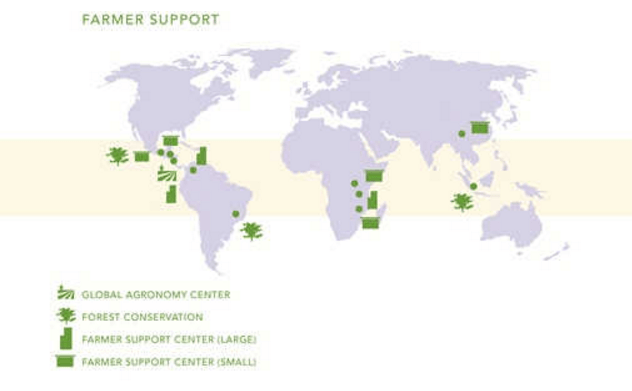Starbucks: Waking up to Climate Change

Starbucks is leading the field in its reaction to climate change by improving its coffee procurement processes.
When you drink your first Starbucks coffee of the morning, you may still be tired because climate change is keeping you up at night. Starbucks’ main ingredient, coffee, is part of the global agricultural industry that will be increasingly affected by climate change in the next 50 years. While risks abound when you source sensitive raw materials for a global brand, Starbucks has increased its upstream presence and developed expertise on growing practices to advise coffee producers on key sustainability issues.
How big is the coffee market?
Coffee is one of the world’s highest consumed commodities. In 2015-16, the International Coffee Organization estimates 8.9 billion kilograms of coffee were produced globally, and the world’s largest coffee exporters include Brazil, Vietnam, Colombia, and Indonesia. South America accounts for 47% of global coffee exports, Asia 31%, Central America and Africa at 10% each, and North America at 2%. [1]
Coffee is best grown in rich soil and high altitudes in the equatorial region. Numerous factors affect the quality and flavor of coffee, and each region offers a unique taste based on chemistry of the soil, weather, rainfall / sunshine, and variety of plant. [2]
Is coffee production affected by climate change?
Yes! Since coffee is dependent on regular sequences of weather events, and because the quality of the product itself is linked to environmental factors, coffee production is extremely prone to climate change. Climate hazards such as higher global temperatures, heavier weather events like rain and wind, changes in rain seasons, and prolonged drought can negatively impact coffee plants in many ways. These climate effects can lead to an increase in pests and diseases, soil erosion and landslides, and overall reduction in output. [3]
How can coffee producers adapt to climate change?
As seen below, it is important to consider the probability and severity of major climate shifts in coffee producing regions when considering potential solutions. If events are highly impactful but happen infrequently, managing risk through insurance can be a viable solution. If climate change leads to frequent high impact events that destroy a region’s ability to produce coffee, it is necessary to substitute coffee plants with other crops that may grow better under new conditions. Finally, if climate change is taking place steadily and without consistent, severe weather events, producers should adapt agricultural practices and plant varieties to maximize production under changing conditions. [3]
How has Starbucks reacted to climate change risks?
As one of the largest coffee purchasers in the world (250 million kg in 2015), Starbucks has proactively tackled risk associated with climate change by moving upstream and helping farmers adapt to changing conditions. The company is committed to purchasing 100% of its coffee from ethical sources, with one of the key criteria being Environmental Leadership. As codified in its C.A.F.E. (Coffee and Farmer Equity) Practices, Starbucks engages with third party verifiers to “help manage waste, protect water quality, conserve water and energy, preserve biodiversity, and reduce agrochemical use” on coffee farms.
An important initiative has been to open a series of Starbucks Support Center locations throughout the equatorial region to help farmers better manage scarce resources and adapt to environmental changes. The Global Agronomy Research and Development Center in Costa Rica in 2013 is researching the regional impact of climate change and developing more adaptable coffee varietals that can ultimately be grown by producers throughout the region. Starbucks issued the first $500 million corporate sustainability bond in 2016 to back these initiatives and ensure that its coffee is grown in a way that protects workers and wildlife. [4] [5]
How can Starbucks further mitigate coffee procurement risks?
Starbucks should expand its Global Agronomy Center network and open locations in Africa and Southeast Asia. These facilities will be able to adapt more nimbly to changes in growing conditions caused by near-term effects of climate change on these continents and provide more specialized advice to local growers. The research centers will also ensure that coffee varietals are continually in development that respond more robustly to potential climate shifts in these regions.
What can Starbucks do to further decrease its environmental footprint?
On the waste and carbon generation side of their retail business, Starbucks has robust sustainability initiatives in place but can take its actions one step further. Starbucks should focus on moving towards 100% biodegradable packaging and cups. While the company mostly uses recyclable packaging, recycling around the world continues to be highly inefficient and still generates waste. Moving to biodegradable products would decrease reliance on fossil fuels as a packaging input and decrease landfill use. [6]
To conclude …
In raw material procurement and operations, Starbucks is leading the field in corporate sustainability. Going forward, the company should continue to promote environmental initiatives on a global scale to provide customers peace of mind with every sip.
(799 words)
[1] “Historical Data on Global Coffee Trade.” International Coffee Organization. Web. http://www.ico.org/new_historical.asp
[2] “Coffee Around The World.” National Coffee Association USA. Web. http://www.ncausa.org/About-Coffee/Coffee-Around-the-World
[3] “Coffee and climate change.” Centre for Agriculture and Biosciences International (CABI). Web. http://www.cabi.org/projects/project/44640
[4] “Starbucks raises $500 million with its first sustainability bond.” Bloomberg. Web.
[5] “Farmer Support Centers.” Starbucks Corporation. Web. http://www.starbucks.com/responsibility/community/farmer-support/farmer-support-centers
[6] “Environment: Pioneering Sustainable Solutions.” Starbucks Corporation, Web. http://www.starbucks.com/responsibility/environment





Great post! I wonder if coffee growers can start to think about diversification of location as a way to mitigate risk in addition to using insurance to achieve that goal. As for Starbucks, I am impressed by their commitment to 100% ethical sources for their coffee, but wonder if that commitment could lead to issues down the line in terms of lack of sustainability in the logistics of the supply chain. Are these ethical sources close enough to keep GHG emissions from trucking down?
Nice post, Alex! I like MM’s curiosity about what coffee growers can do. I wonder though how many coffee growers actually have the resources to diversify their locations. The majority of coffee producers in some of the biggest exporting countries (Mexico, Costa Rica, Guatemala) are small/family farms. The time and capital required to invest in new lands to ensure ongoing production may simply be too high. My understanding is that in Brazil, however, coffee is primarily produced on large plantations – so there may be some opportunity there.
This does have me wondering – are small coffee farmers completely dependent on a stable climate to maintain their businesses? Is the only way for these groups to maintain their livelihoods to stop climate change altogether?
I enjoyed reading this post while drinking my Starbucks coffee! It is fascinating to comprehend how vulnerable Starbucks might be to climate change. Although more sustainable practices like biodegradable cups is a worthwhile goal, I am not sure that it tackles the underlying business vulnerability of Starbucks reliance on coffee bean yields. The line about Costa Rica’s attempts to develop weather resistant coffee beans really sparked my interest. I’d love to learn more about Starbucks investments in developing more adaptable coffee varietals. Has Starbucks made any R&D investments in this type of technology? If they were successful, they could not only ensure the future of their supply but also positively impact the lives of their coffee bean farmers.
Great post Alex! I found this post particularly interesting as avid Starbucks lover. I have always admired Starbuck’s environmental leadership. In addition to the programs you have mentioned, Starbucks has run the Grounds for Your Garden program, which reduces the organization’s environmental impact, for over 20 years. Another thing Starbucks has done to reduce its environmental footprint includes constructing LEED –Certified Stores (over 1,000). Although the organization has made much progress, I’d like to see more done to help local farmers adjust to the company’s supply chain requirements.
https://news.starbucks.com/news/starbucks-coffee-grounds-for-the-garden